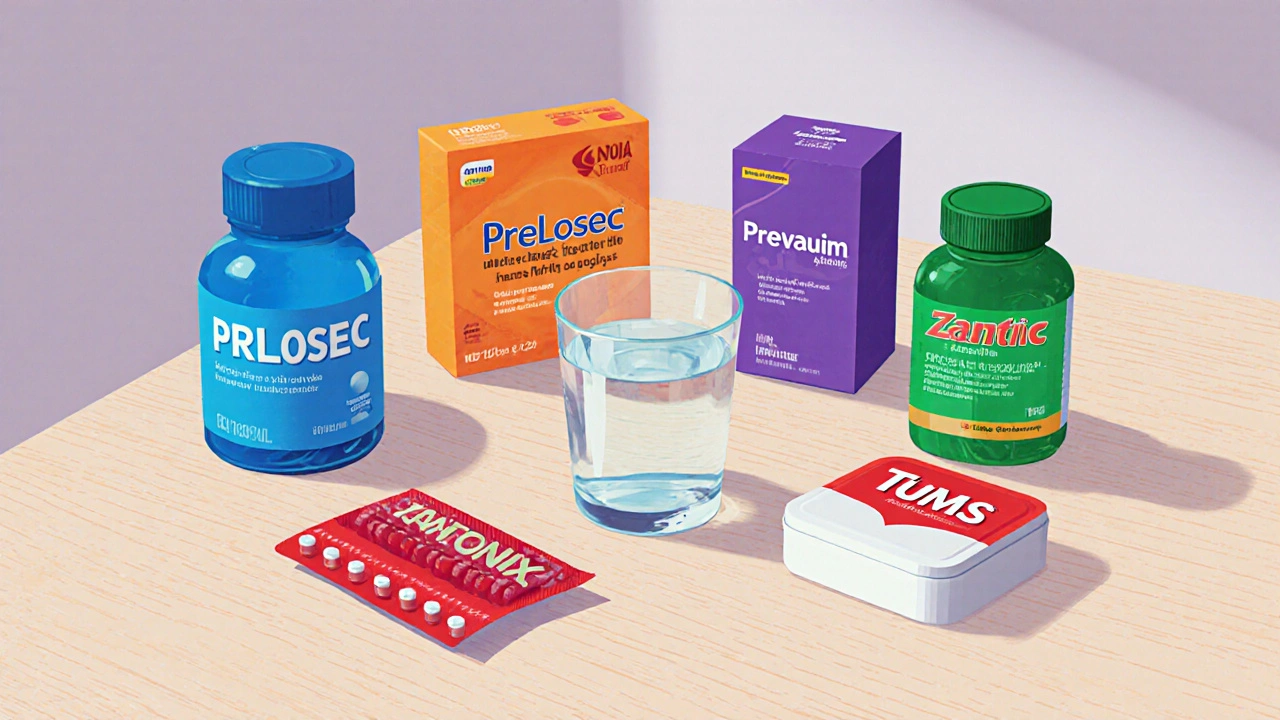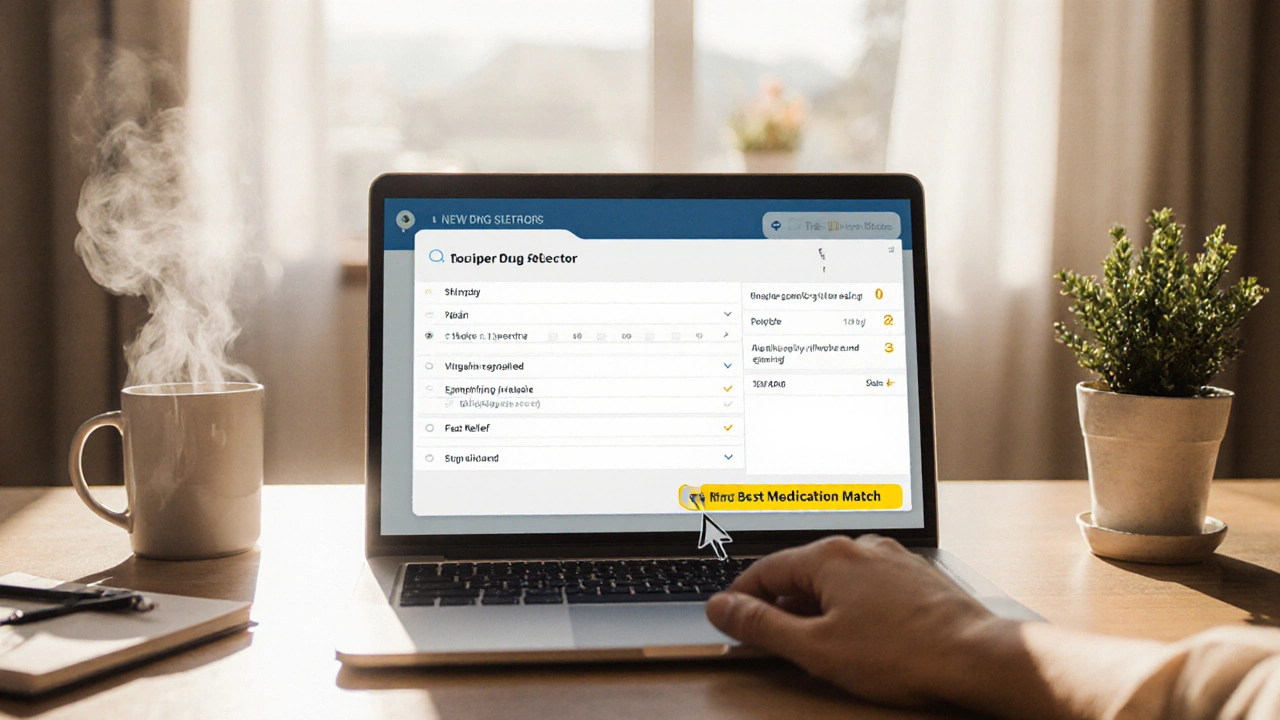Prilosec vs Alternatives: Drug Selector Tool
Recommended Medication
Select criteria above and click "Find Best Medication Match"
Key Takeaways
- Prilosec (omeprazole) is a prescription‑grade PPI with strong acid suppression but higher cost than many OTC options.
- Newer PPIs like Nexium (esomeprazole) and Prevacid (lansoprazole) offer similar efficacy with slightly different dosing schedules.
- H2 blockers such as Zantac (ranitidine) work faster but often need multiple doses daily.
- Antacids like Tums (calcium carbonate) provide immediate relief for mild symptoms but don’t heal the esophagus.
- Choosing the right drug depends on symptom severity, insurance coverage, speed of relief, and safety profile.
When you search for Prilosec vs alternatives, you probably want to know which drug will calm your heartburn fastest, cost the least, and keep side effects to a minimum. Below we break down the science, the price tags, and the real‑world pros and cons of the most common acid‑reflux medications.
What Is Prilosec (Omeprazole)?
Prilosec is the brand name for omeprazole, a proton pump inhibitor (PPI) that blocks the stomach’s acid‑producing pump at its source. By inhibiting the H⁺/K⁺‑ATPase enzyme, it reduces gastric acidity for up to 24hours after a single dose. Typical adult dosing is 20mg once daily before breakfast, and most patients notice symptom improvement within 3-5days. Because it works on the final step of acid production, omeprazole is more potent than older H2 blockers.
How Proton Pump Inhibitors (PPIs) Work
PPIs target the gastric parietal cell’s proton pump, the final catalyst that converts hydrogen ions into hydrochloric acid. When the pump is switched off, the stomach’s pH rises from around 1-2 to 4-5, providing a less corrosive environment for the esophageal lining. This mechanism explains why PPIs are the go‑to treatment for chronic conditions like gastroesophageal reflux disease (GERD) and peptic ulcers.

Top Alternatives to Prilosec
Below are the most widely used alternatives, each with its own dosing quirks, cost profile, and safety notes.
Nexium (esomeprazole)
Nexium is an enantiomer of omeprazole, meaning it’s a chemically tweaked version that some studies suggest offers slightly faster symptom relief. The standard dose is 20mg once daily, a timing identical to Prilosec, but Nexium is approved for both prescription and over‑the‑counter (OTC) use in Canada.
Prevacid (lansoprazole)
Prevacid works on the same pump but has a longer half‑life, allowing once‑daily dosing for most patients. The usual dose is 15mg in the morning. It’s available by prescription only, though a lower 15mg dose is sold OTC in some provinces.
Protonix (pantoprazole)
Protonix is often chosen for patients who experience drug interactions with omeprazole because it’s metabolized differently (via CYP2C19). The typical regimen is 40mg once daily. It remains prescription‑only in Canada.
AcipHex (rabeprazole)
AcipHex offers a rapid onset-some users report relief within 2days. The standard dose is 20mg daily. Like Nexium, a 20mg strength is available OTC in certain regions.
Zantac (ranitidine)
Zantac belongs to the H2‑blocker class, which reduces acid by blocking histamine receptors on parietal cells. It works faster than PPIs (often within an hour) but provides shorter‑lasting relief. Typical dosing is 150mg twice daily. Note: recent recalls have limited its availability, so many pharmacies now stock alternatives like Pepcid (famotidine).
Tums (calcium carbonate)
Antacids such as Tums neutralize existing stomach acid rather than stopping new acid from forming. They’re perfect for occasional heartburn: chew 2-4 tablets for immediate relief, lasting about 1-2hours. Because calcium carbonate also supplies dietary calcium, it can be a supplemental source for bone health.
Side‑by‑Side Comparison
| Brand | Generic | Drug Class | Typical Dose | Time to Relief | OTC Availability (Canada) | Avg. Monthly Cost (CAD) | Common Side Effects |
|---|---|---|---|---|---|---|---|
| Prilosec | Omeprazole | PPI | 20mg once daily | 3‑5days | Prescription only (20mg), OTC 10mg | ≈$25/month | Headache, nausea, diarrhea |
| Nexium | Esomeprazole | PPI | 20mg once daily | 2‑4days | Both prescription & OTC (20mg) | ≈$30/month | Upper‑respiratory infection, abdominal pain |
| Prevacid | Lansoprazole | PPI | 15mg once daily | 3‑5days | Prescription; OTC 15mg in some provinces | ≈$28/month | Diarrhea, constipation, abdominal bloating |
| Protonix | Pantoprazole | PPI | 40mg once daily | 3‑5days | Prescription only | ≈$32/month | Headache, nausea, joint pain |
| AcipHex | Rabeprazole | PPI | 20mg once daily | 2‑3days | Both prescription & OTC (20mg) | ≈$27/month | Dizziness, flatulence, rash |
| Zantac | Ranitidine | H2‑blocker | 150mg twice daily | Within 1hour | OTC (150mg) | ≈$12/month | Headache, fatigue, constipation |
| Tums | Calcium carbonate | Antacid | 2-4 tablets as needed | Immediate (5‑10min) | OTC | ≈$5/month (typical use) | Gas, mild constipation |
How to Pick the Right Option for You
- Severity and frequency. If you have daily heartburn or diagnosed GERD, a prescription PPI like Prilosec or Nexium offers consistent acid control. For occasional spikes, an H2 blocker or antacid may be enough.
- Speed of relief. H2 blockers (Zantac) act within an hour, while PPIs need a few days. Combine an antacid with a PPI for instant relief while the PPI builds up.
- Cost and insurance. Check your provincial drug plan. Generic omeprazole often costs less than brand‑name versions. OTC 10mg packs of Prilosec can be a budget‑friendly bridge.
- Drug interactions. Omeprazole and Prilosec inhibit CYP2C19, potentially raising levels of clopidogrel, certain antivirals, and some antidepressants. Pantoprazole (Protonix) has a lower interaction risk.
- Long‑term safety. Chronic PPI use (beyond 8‑12weeks) is linked to vitaminB12 deficiency, magnesium loss, and higher fracture risk. If you need a PPI for months, discuss intermittent dosing or a step‑down plan with your doctor.
Common Pitfalls and Safety Tips
- Never double‑dose. Taking two PPIs at once doesn’t double the effect but raises side‑effect risk.
- Take the pill 30‑60minutes before a meal. Food can delay absorption and blunt the drug’s impact.
- Avoid crushing or chewing PPIs; they’re designed as enteric‑coated tablets to survive stomach acid.
- If you’re pregnant or nursing, stick with the lowest effective dose and talk to your provider-most PPIs are category B, but data vary.
- Watch for rebound acid hypersecretion when stopping a PPI abruptly. Tapering down over a week or two reduces the rebound effect.

Frequently Asked Questions
Can I switch from Prilosec to an OTC PPI without a prescription?
Yes. In Canada, 10mg omeprazole tablets are sold OTC. They’re less potent than the 20mg prescription strength, so you may need to take them twice daily for moderate symptoms. Always read the label and consult a pharmacist if you’re unsure.
Is it safe to take Prilosec with my blood thinner?
Omeprazole can interfere with the activation of clopidogrel, a common antiplatelet drug. If you’re on clopidogrel, discuss switching to pantoprazole (Protonix) or using a lower PPI dose.
How long should I stay on a PPI before stopping?
For most uncomplicated GERD cases, an 8‑week course is enough. If symptoms return, your doctor may recommend a maintenance dose of the lowest effective strength or an H2 blocker on an as‑needed basis.
Are there natural alternatives to PPIs?
Lifestyle changes-weight loss, elevating the head of the bed, avoiding late‑night meals, and limiting caffeine or alcohol-can dramatically cut reflux. Some people find relief with deglycyrrhizinated licorice (DGL) or aloe vera juice, but these aren’t replacements for severe cases.
What should I do if I experience severe abdominal pain while on a PPI?
Stop the medication and contact your healthcare provider immediately. Severe pain could signal a rare ulcer complication or an allergic reaction that needs prompt evaluation.
Bottom line: Prilosec remains a solid choice for daily acid control, but newer PPIs, H2 blockers, and antacids each have niches where they shine. By matching the drug’s strengths to your specific pattern of heartburn, you’ll avoid unnecessary costs and side effects. Talk to your pharmacist or physician to tailor a plan that fits your budget and health goals.

8 Comments
I've been on omeprazole for years and honestly didn't realize how much better my sleep got once I stopped eating right before bed. Also, Tums are my secret weapon for late-night cravings gone wrong. 🍕😂
People don't understand that popping PPIs like candy is just a band-aid on a broken spine of poor lifestyle choices. You think your stomach is the problem? It's your 3 a.m. pizza binges, your 6 sodas a day, your refusal to elevate your mattress even an inch. The science is clear-your body isn't broken, your habits are. And no, a $5 bottle of Tums won't fix that. You need discipline, not drugs.
The CYP2C19 metabolic pathway distinction between pantoprazole and omeprazole is clinically significant in polypharmacy patients, particularly those on clopidogrel or voriconazole. While OTC access increases adherence, the risk-benefit calculus shifts with chronic use-especially regarding hypomagnesemia and intestinal microbiome disruption. A structured step-down protocol is preferable to abrupt discontinuation.
Lyn is right but also kind of a drama queen 🤡 I’ve been off PPIs for 18 months now and I just eat less crap sleep better and lift weights. No magic pill. Your gut isn’t broken it’s just mad you treat it like a trash can. Also why is everyone still talking about Zantac? It’s been banned for years. Get with the program.
This is actually super helpful! I’ve been on Prilosec for 3 years and didn’t know about the rebound effect. I’m going to talk to my doc about switching to an H2 blocker on off-days. Also Tums are my new best friend 😊🙏
It is imperative to note that the over-the-counter availability of 10 mg omeprazole does not equate to therapeutic equivalence with the 20 mg prescription formulation. Self-medication without medical supervision may result in suboptimal acid suppression, prolonged mucosal damage, and increased risk of Barrett’s esophagus. Furthermore, the use of antacids as primary therapy for chronic GERD is not evidence-based and constitutes a misallocation of therapeutic resources.
I love how this breaks it down so clearly. I used to think PPIs were the only answer until I started doing the 8-week challenge with my nutritionist-cut out caffeine, no food after 7pm, and slept on a wedge pillow. My heartburn dropped by 80%. Now I only take Tums when I eat out. It’s not about the drug-it’s about reclaiming your body. You’ve got this 💪❤️
You all are missing the point. If you’re still on Prilosec after 2 months, you’re doing it wrong. The real solution is alkaline water, apple cider vinegar, and not being a lazy sloth who eats fast food every day. I’ve helped 47 people get off PPIs. You just need to be willing to change.
Write a comment